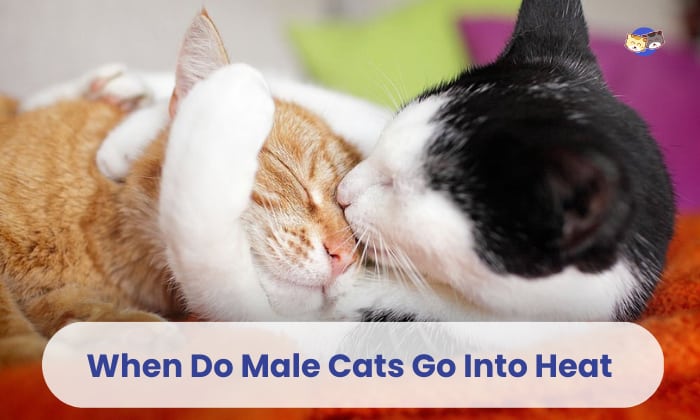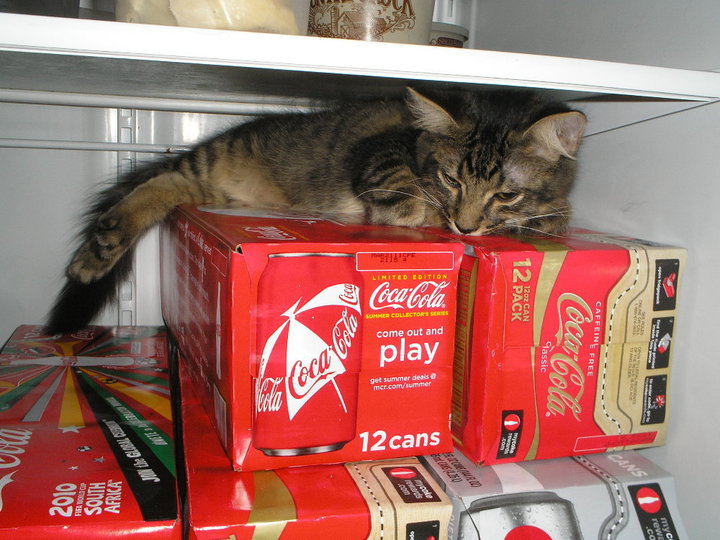Why Does My Cat Have One Black Whisker?

A cat may have one black whisker due to pigmentation variation, which is common and harmless. Your cat having one black whisker is likely due to pigmentation variation, which is a common and harmless occurrence.
Whiskers, also known as vibrissae, are sensory hairs that play a crucial role in a cat’s perception of their surroundings. While most whiskers are typically white or light-colored, it is not uncommon for a cat to have one or more black whiskers.
This pigmentation variation can happen naturally and is no cause for concern. Keep in mind that whiskers serve an important purpose for your feline friend, helping them navigate and investigate their environment with precision and accuracy.
Understanding Whiskers In Cats
Whiskers: An Essential Sensory Tool
Whiskers, also known as vibrissae, are not just ordinary hairs on your cat’s face. They are actually a remarkable sensory tool that serves an essential purpose in their daily lives. These long, thick hairs are rooted deep within the skin and are usually arranged in four rows on each side of a cat’s muzzle, as well as above their eyes and even on the back of their front legs. But have you ever wondered why your cat has that one black whisker? Let’s dive into the fascinating world of whiskers to find out!
The Structure And Function Of Whiskers
Whiskers are more than just visually striking features on your feline friend’s face. They serve as incredible tools for navigation, communication, and sensory perception. Each whisker is embedded in a hair follicle surrounded by a highly sensitive network of nerves. This structure allows the whiskers to transmit even the subtlest of movements to the sensory cells, providing cats with valuable information about their surroundings.
The whiskers’ remarkable sensitivity is due to their connection to a high number of nerves. These nerves are directly linked to the sensory areas of the cat’s brain, making whiskers an integral component of their overall perception and awareness.
Additionally, whiskers are able to detect even the slightest changes in air currents, allowing cats to gauge the size, shape, and proximity of objects and navigate through cramped spaces with remarkable precision. Whiskers help cats determine whether they can fit into tight spaces or squeeze through narrow gaps without getting stuck. They also play a crucial role in hunting, helping cats judge distances accurately and ambush their prey effectively.
| Key Functions of Whiskers | Example |
|---|---|
| Navigation | A cat using its whiskers to measure the width of a gap before attempting to jump across it. |
| Communication | Whiskers positioned forward indicate a curious or alert cat, while whiskers pulled back against the face signal fear or aggression. |
| Sensory Perception | A cat using its whiskers to determine the location of an object in low-light conditions. |
Cat whiskers are not only useful for their own sensory needs but can also give us valuable insights into their overall health. If you notice any changes in the appearance, symmetry, or condition of your cat’s whiskers, it may be worth consulting with a veterinarian. Healthy whiskers are typically straight, strong, and equally distributed.
The black whisker you’ve noticed on your cat is simply one of the many remarkable tools they possess in their whisker repertoire. From aiding their navigation and communication to enhancing their sensory perception, whiskers are a vital part of a cat’s daily life. Take a moment to appreciate these unique sensory wonders next time you observe your feline companion!
The Role Of Whisker Coloration
Whiskers are a fascinating feature of our feline companions. Not only do they add to their adorable appearance, but they also serve several important functions. One intriguing aspect of a cat’s whiskers is their coloration. Whiskers can vary in color, with most cats having white or light-colored whiskers. However, you may have noticed that your cat has one black whisker amidst the rest. Let’s delve deeper into the reasons behind these natural color variations.
The Natural Color Variations Of Whiskers
Just like humans have different hair colors and textures, cats also display natural variations in their whiskers. Whiskers can be white, black, gray, or even different shades of brown. These color variations are determined by the pigmentation present in the hair follicles. The same pigmentation that applies to a cat’s fur also applies to their whiskers.
Certain breeds may have a greater tendency for darker-colored whiskers. For example, cats with solid black coats, like the Bombay breed, often have black or dark-colored whiskers. On the other hand, cats with lighter-colored coats, such as the Siamese breed, tend to have lighter-colored whiskers. However, keep in mind that individual variations can still occur, even within specific breeds.
Exploring The Phenomenon Of One Black Whisker
Among the natural color variations of whiskers, the phenomenon of having one black whisker amidst the rest is not uncommon. It is often referred to as a “lucky whisker.” While it may seem peculiar or even remarkable, there is no need to be concerned about this unique feature in your feline friend.
Just like how humans may have a strand of hair that deviates from their natural hair color, cats can also have whiskers that differ in color. Sometimes, this single black whisker is simply an individual oddity and poses no health or behavioral issues for your cat.
Whiskers are highly sensitive sensory organs that help cats navigate and understand their surroundings. They play a crucial role in spatial awareness, detecting movements, and assessing objects’ proximity. Consequently, the color of a single whisker would not affect its functionality or significance.
Remember, your cat’s unique black whisker is not an indicator of any underlying health concerns. Embrace this idiosyncrasy as part of your cat’s distinctive and endearing physical traits.
Possible Explanations For A Single Black Whisker
Have you ever noticed a single black whisker on your cat? It’s not uncommon for cats to have a unique whisker color here and there. While it may seem mysterious, there are actually a few possible explanations for why your cat has that one black whisker. Let’s explore some of these explanations:
Genetic Factors: Melanin Production
One possible explanation for a single black whisker is genetics. Just like humans, cats inherit certain traits from their parents. Whisker color is determined by the production of melanin, the pigment responsible for hair, skin, and eye color. It’s possible that your cat inherited a genetic variation that causes the production of more melanin in that particular whisker, resulting in its black color.
Aging Process: Hair Follicle Changes
As cats age, their hair follicles can go through changes. This can include changes in pigment production, which could explain the appearance of a single black whisker. Over time, the hair follicle may start producing more melanin, causing the whisker to darken. While aging is a natural process, it’s interesting to see how it can manifest in the color of your cat’s whiskers.
Environmental Factors: Dirt And Pigments
Another possible explanation for a single black whisker is environmental factors. Cats are curious creatures, always exploring their surroundings. It’s possible that your cat came into contact with dirt or pigments that stained that particular whisker. Dirt, dust, or even certain substances can temporarily darken a whisker. However, if the whisker remains black for an extended period of time, it’s more likely due to other factors mentioned previously.
Black Whiskers And Health Conditions
When it comes to our furry friends, it’s natural to be curious about the little quirks and peculiarities that make them unique. One such intriguing thing is when you notice your cat has a black whisker amongst their usual white or light-colored ones. You may wonder, why does my cat have one black whisker? Is there a reason behind it? In this blog post, we’ll explore the fascinating relationship between black whiskers and various health conditions that may be affecting your feline companion.
Hyperpigmentation And Melanoma
One possible reason why your cat has a black whisker is hyperpigmentation. Hyperpigmentation occurs when there is an increase in the production of melanin — the pigment responsible for the color of our skin, hair, and eyes. It can affect various parts of the body, including the whiskers. While most cases of hyperpigmentation in cats are harmless and benign, it’s important to keep an eye on any changes in color or texture of the whiskers.
In rare instances, a black whisker may be an indication of a more serious condition such as melanoma. Melanoma is a type of skin cancer that occurs when melanocytes, the cells responsible for producing melanin, become abnormal and start to grow uncontrollably. Regularly examining your cat’s whiskers and consulting with a veterinarian can help identify any concerning changes and ensure early intervention if necessary.
Other Health Conditions Linked To Black Whiskers
Aside from hyperpigmentation and melanoma, there are other health conditions that may manifest as black whiskers in cats. These conditions vary in severity and may require proper diagnosis and treatment. Here are a few examples:
- Dermatitis: Inflammation of the skin can lead to changes in whisker color. Cats with dermatitis may exhibit black whiskers due to the irritation and inflammation of the hair follicles.
- Allergies: Cats can develop allergies to various substances, including certain foods or environmental triggers. Black whiskers can be a sign of an allergic reaction.
- Fungal Infections: Certain fungal infections, such as ringworm, can affect a cat’s coat and whiskers. Black whiskers may be a result of the infection.
If you notice your cat has black whiskers that seem out of the ordinary or if your feline companion exhibits other concerning symptoms, it’s crucial to seek veterinary guidance. A thorough examination, proper diagnosis, and appropriate treatment can help ensure your cat’s overall health and well-being.
Caring For Your Cat’s Whiskers
If you’ve ever wondered why your cat has one black whisker, it’s likely just a natural variation in coloration. While most whiskers are white, some cats may have differences in pigmentation, resulting in a black whisker. It’s nothing to be concerned about and doesn’t affect your cat’s health or well-being.
Proper Whisker Care And Maintenance
As a responsible cat owner, it’s important to understand the significance of caring for your cat’s whiskers. Whiskers may seem like just another feature on your cat’s face, but they play a crucial role in your feline friend’s daily life. Properly maintaining your cat’s whiskers can ensure their overall well-being and comfort.
Whiskers are highly sensitive, long, and thicker hairs that protrude from your cat’s face. They are deeply rooted in the skin and are connected to sensory nerves, making them an essential tool in your cat’s day-to-day activities. Cats use their whiskers to gauge distances, navigate through narrow spaces, and even detect potential dangers.
When it comes to caring for your cat’s whiskers, a few simple steps can go a long way in ensuring their health and functionality:
1. Keeping the Whiskers Clean
Your cat’s whiskers can easily collect dirt, dust, and debris throughout the day. Regularly cleaning your cat’s whiskers with a soft, damp cloth can help prevent any potential irritations or discomfort.
2. Avoiding Whisker Trimming
As tempting as it may be to give your cat a grooming session, it’s crucial to never trim or cut their whiskers. Whiskers serve as a crucial sensory tool for your furry friend, and cutting them can leave them disoriented and confused. It’s best to leave their whiskers intact to allow them to function naturally.
Monitoring Whisker Health And Appearance
Ensuring your cat’s whiskers are healthy and in good condition is an important part of their overall well-being. Regularly monitoring their whisker health and appearance can help detect any potential issues or changes that may require attention.
Here are a few things to consider when monitoring your cat’s whiskers:
1. Length and Thickness
Check the length and thickness of your cat’s whiskers on a regular basis. Whiskers should be sturdy, not frayed or broken. If you notice any abnormalities, such as thinning or uneven whiskers, it’s best to consult your veterinarian for further evaluation.
2. Vibrant Color
The color of your cat’s whiskers can vary depending on their fur color. However, a black whisker that stands out among the rest is relatively common. It’s important to note that this is usually not a cause for concern, as whiskers can develop different colors naturally.
3. Behavioral Changes
Changes in your cat’s behavior, such as excessive pawing at their face, shaking their head, or sensitivity around their whiskers, may indicate a possible issue. Keeping an eye out for these changes can help you address any potential whisker-related problems promptly.
Remember, caring for your cat’s whiskers is an important aspect of their overall health and well-being. By following proper whisker care and regularly monitoring their health and appearance, you can help ensure that your feline friend enjoys their daily adventures to the fullest.

Credit: www.reddit.com
Frequently Asked Questions On Why Does My Cat Have One Black Whisker?
Why Does My Cat Have One Black Whisker?
Your cat may have one black whisker due to genetics. Just like humans have different hair colors, cats can have different whisker colors. Black whiskers are common for cats with dark fur, and it adds to their unique appearance. It’s perfectly normal and nothing to be concerned about.
Can A Cat Have Multiple Black Whiskers?
Yes, it’s completely normal for a cat to have multiple black whiskers. Many cats have a mix of black, white, or even ginger-colored whiskers. The color of a cat’s whiskers often corresponds to the color of their fur. If your cat has multiple black whiskers, it’s just another charming and unique feature.
Do Black Whiskers Serve A Purpose?
Whiskers are highly sensitive and act like a cat’s sensory organ. They play a crucial role in helping the cat navigate and explore its environment. Black whiskers, just like any other color whiskers, help cats to detect objects, judge distances, and even communicate with other cats.
They are an essential part of a cat’s sensory system.
Conclusion
The presence of one black whisker on your cat is not uncommon and may simply be a result of natural variation. While it may not hold any significant meaning or health concerns, it certainly adds to the unique charm of your feline friend.
So, embrace that adorable black whisker as one of the many quirks that make your cat special!






